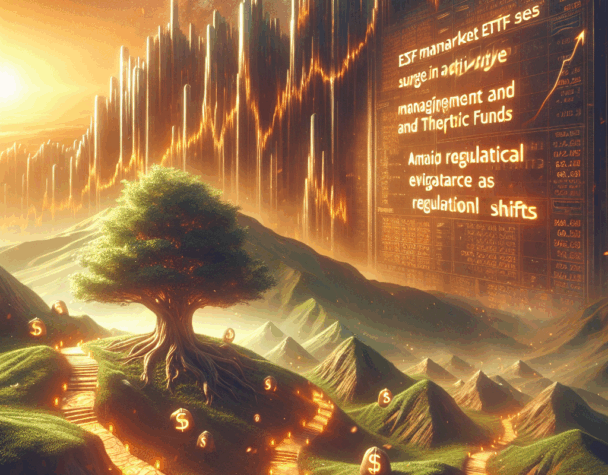
ETF Market Sees Surge in Active Management and Thematic Funds Amid Regulatory Shifts
Wed, June 11, 2025ETF Market Sees Surge in Active Management and Thematic Funds Amid Regulatory Shifts
The exchange-traded fund (ETF) market is experiencing significant transformations, marked by a notable increase in actively managed and thematic funds. These developments are influenced by evolving regulatory landscapes and shifting investor preferences.
Rise of Actively Managed ETFs
In 2024, the global asset management industry reached $128 trillion, with actively managed ETFs playing a pivotal role. Although they constitute only 7% of the global ETF assets, their growth rate surpasses that of passive products. In the U.S., these ETFs have amassed over $1 trillion, with more than 80% of new launches in 2025 being actively managed, capturing 27% of net ETF inflows in 2024. Their appeal lies in combining professional management with the flexibility and cost-effectiveness of traditional ETFs. European markets are also witnessing growth, with net inflows of $20 billion in 2024. However, adoption in Spain remains slower due to tax considerations. Leading asset managers like JP Morgan, Pimco, Fidelity, and Amundi are at the forefront, offering innovative products such as the JEPI, the world’s largest active ETF. Technological advancements, including artificial intelligence, are further enhancing this segment, solidifying active ETFs as a modern and sustainable investment alternative. Los ETF se desmelenan: la gestión activa llega para quedarse
Emergence of Thematic and Exotic ETFs
Investment firms are rapidly introducing thematic and exotic ETFs to cater to investors’ growing interest in digital assets and speculative investments. Recent launches include funds tracking cryptocurrencies like Cardano and Litecoin, memecoins such as Dogecoin and $TRUMP, non-fungible tokens (NFTs) like Pudgy Penguins, and even companies purportedly dealing in alien technology. This trend is driven by investors’ desire for novel investment options and Wall Street’s strategy to capitalize on retail investors’ appetite for unique products. The momentum is bolstered by a more accommodating regulatory environment under the current administration, particularly with Paul Atkins, known for his crypto-friendly stance, leading the Securities and Exchange Commission (SEC). This has facilitated the introduction of new ETFs tied to crypto futures and digital assets. While some industry professionals celebrate this financial innovation, others express skepticism about the long-term viability and demand for such speculative products, cautioning that the exuberance could mislead inexperienced investors and potentially tarnish the broader ETF industry’s reputation. Fund firms court ‘bored’ investors with flurry of exotic ETF launches
Regulatory Developments and Market Dynamics
Regulatory changes are significantly impacting the ETF landscape. The Supreme Court’s June 2024 decision to overturn the Chevron doctrine, which had previously granted regulatory agencies broader authority in interpreting laws, has spurred the launch of new ETFs. For instance, the Free Markets ETF (FMKT.P), trading on the NYSE, aims to invest in companies likely to benefit from the current administration’s deregulation initiatives. This ETF’s portfolio includes diverse investments such as Bitcoin, gold, and stocks from sectors expected to gain from deregulation, ranging from mid-sized financial firms to the nuclear energy industry. Its top holdings include Uranium Energy Corp, Robinhood Markets, and Old National Bancorp. The founders emphasize that while the ETF aligns with certain political trends, its focus is on profiting from the expected economic impacts of deregulation. US firms launch ETF to capitalize on Trump’s deregulation push
Additionally, Trump Media & Technology Group (TMTG) has filed an application with U.S. regulators to launch the “Truth Social Bitcoin ETF,” aiming to hold Bitcoin directly and be listed on the NYSE Arca exchange. This move is part of a broader push by the administration to promote digital assets, including reversing previous crypto regulations and backing digital currency firms. Despite past skepticism of Bitcoin, the administration now strongly endorses digital assets, hosting events for major holders of the $TRUMP memecoin and pledging to build a Bitcoin treasury using $2.5 billion in planned fundraising. However, experts remain skeptical of the fund’s long-term potential due to the already crowded market dominated by firms like BlackRock and Fidelity. Trump Media seeks to launch ‘Truth Social bitcoin ETF’
Challenges and Future Outlook
Despite the rapid growth and innovation in the ETF market, challenges persist. A significant number of investment managers face criticism for promoting ETFs as actively managed while closely mirroring benchmark indices, a practice termed “shy active” by Morningstar. Transparency concerns, especially due to European regulations mandating daily portfolio disclosures, have impeded the launch of genuinely active ETFs, as managers fear revealing proprietary trades. However, new semi-transparent structures introduced in Luxembourg and Ireland are expected to encourage truly active fund strategies by protecting trade confidentiality. Experts emphasize the importance of transparency and investor awareness about what such ETFs truly offer. Despite claims of misleading practices, some argue for the utility of low tracking error funds, provided their strategies and performance metrics are clearly disclosed. The active ETF market remains nascent in Europe, but anticipated regulatory changes may lead to more authentic offerings in the near future. Investment managers accused of misleading market over ‘active’ ETFs
In conclusion, the ETF market is undergoing a dynamic evolution, characterized by the rise of actively managed and thematic funds, influenced by regulatory shifts and changing investor appetites. While these developments present new opportunities, they also pose challenges that require careful navigation by investors and industry participants alike.

